Understanding backlinks is crucial in SEO, especially for business owners and marketing professionals. Your backlink profile holds valuable insights into your website’s rankings and its perceived authority by search engines. Therefore, it’s safe to say you will be spending some time building them if you want to rank at the top.
Here, we’ll look at what goes into a backlink profile and how you can distinguish if yours is good – or leans more towards the bad side.
What exactly is the definition of a backlink profile
A backlink profile in SEO is the collection of all incoming backlinks to a website. In general, analyzing your full backlink profile is best done using various data sources, such as Google Search Console and third-party backlink checkers, which help you understand your website’s authority from a search engine perspective.
If backlinks are the votes of trust other websites give you, then a backlink profile could be seen as the total average score for your website. A backlink profile is generally used to address all known backlinks pointing to your website.
This term is often used when SEO professionals talk about analyzing the backlinks of a website. As an analogy, think about how sales reps analyze their sales pipeline. In this case, they assess the quantity and quality of their leads. Similarly, a backlink profile aims to achieve the same but in an SEO context, essentially answering how many backlinks you have and evaluating their quality.
Basics of a backlink profile
On its own, a backlink profile is a tangible concept, but not inherently useful. However, when put in a specific context, it gives the word a better meaning and purpose. When analyzing all the backlinks of a website, your first step should be to gather all that data in one place – ultimately creating your website’s backlink profile.
Similarly, when you’re actively building links (e.g., running a specific link-building campaign), it’s important to monitor your backlink profile closely. This helps avoid building too many similar links to a particular page on your website, which can alarm Google that you’re involved in some link scheme.
Because of technological limitations, a backlink profile never truly contains absolutely all the links your website has. It typically includes the majority of links that web crawlers can easily find. Changes on the internet occur faster than any current technology can track as thousands of new websites are created every day, each with multiple pages.
As a result, it’s reasonable to consider only the links accessible on platforms like Google Search Console and other third-party link-building tools to be the full backlink profile of your website.
Additionally, a backlink profile usually refers to all of your website’s links for a specific condition – such as a certain time period. This is because data may not always be immediately available, and sometimes backlinks can take several months to appear in popular tools.
What does your backlink profile measure?
When we talk about a website’s backlink profile, we are measuring two key things: how many backlinks your site has, and how good these backlinks are. A backlink profile isn’t just a simple list; it gives you valuable information in different ways, depending on what you need to know.
Let’s break down what your backlink profile can show you:
-
Keyword Frequency in Anchor Texts
This tells you how often certain keywords appear in the anchor texts of your backlinks.
-
Backlink Origins
You can see which countries your backlinks are coming from.
-
Spam Scores
This is about the quality of your backlinks. A spam score helps you identify which backlinks might be harmful or of low quality, often referred to as ‘toxic links’.
-
Types of Anchor Texts
Your backlink profile categorizes the anchor texts based on their meaning and relation to your keywords.
The role of backlink analysis?
Google has previously stated that not all links you receive bring you value. Because of this, especially when starting a new project, SEO specialists analyze the company’s backlink profile to understand their website’s authority.
When looking at a backlink profile, SEO specialists typically note the highest quality websites that link back. After that, they often manually review some of the top links to see if they originate from a piece of content – and in what context they appear.
Additionally, in some cases, an SEO professional might perform a backlink analysis for a website that has been penalized by Google.
In such cases, SEOs would find the harmful backlinks that have caused the penalty and manually request Google to disregard them (a process also known as disavowing links). Recent updates in Google, however, are attempting to streamline this process. The June and July 2021 Google Spam updates aim to automatically exclude low-value links from the rankings of websites.
What is a good backlink profile?
A good backlink profile in SEO, also known as a natural backlink profile, as a rule of thumb, consists of many high-quality backlinks. But let’s closely examine a specific example of what a good backlink profile looks like.
We’ll look at a random mid-sized company’s link profile using Morninscore’s link scanner, which gives a complete overview of any website’s link profile. The randomly selected example of a good backlink profile is bloomandwild.com – a flower delivery service in the UK.
5 main characteristics of a high-quality backlink profile:
1. Backlinks come from diverse sources
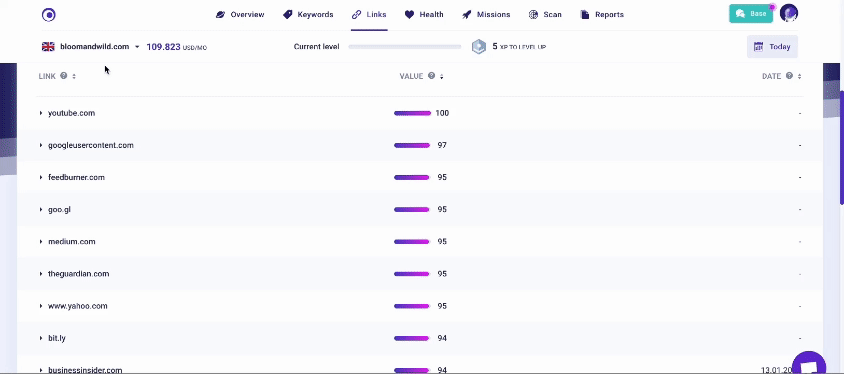
In Bloom & Wild’s example, their backlinks come from a variety of websites, including blogs, lots of news sites, online magazines, and other pages. This diversity shows search engines that a wide range of sites value their content.
2. Backlinks are from relevant websites
The majority of Bloom & Wild’s backlinks are from websites that are relevant to their business and their website’s content. For example, Good Housekeeping lifestyle magazine mentioned Bloom & Wild in their product roundup article about gift ideas for friends.
As another example, if your website is about fitness, getting a backlink from a health and wellness site is more beneficial than one from an unrelated field like automotive repair.
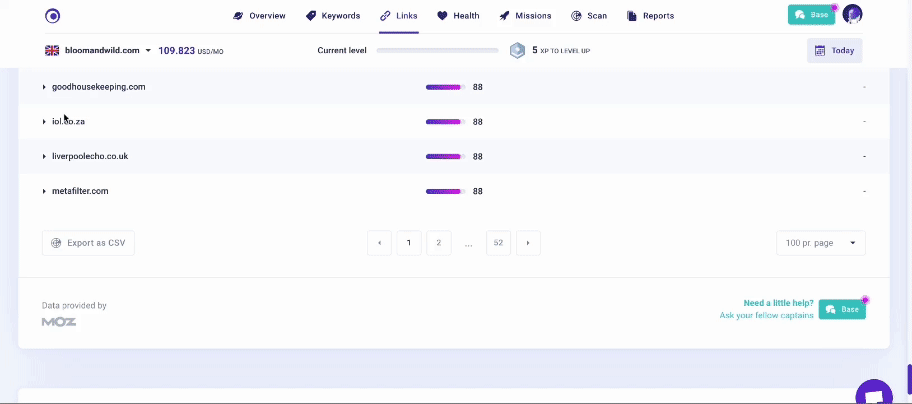
3. Availability of links from high-authority sites
Links from websites that are are considered reputable and trustworthy by search engines, are, of course, more valuable. In Morningscore’s backlink checker we show a value of each domain pointing to the website as well as a page value of a specific landing page.
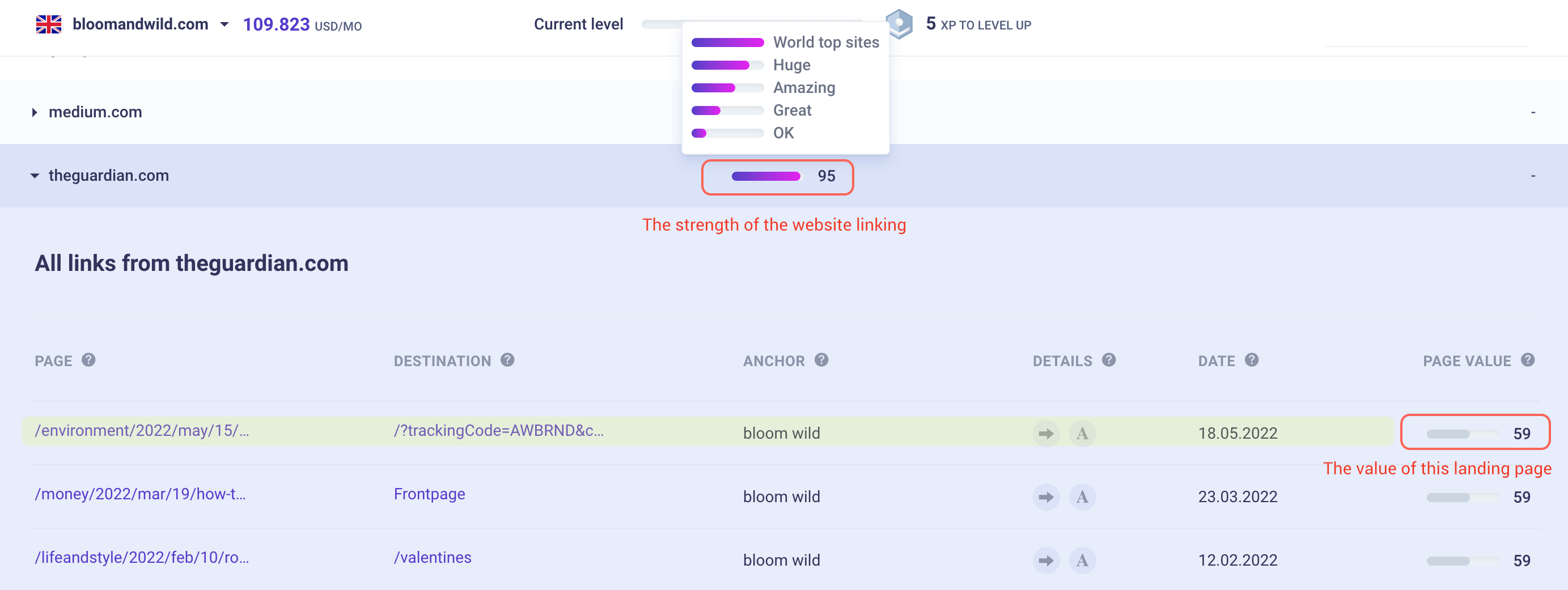
Please note, it’s perfectly normal if around half of your links are from less authoritative sources. Bloom & Wild have links from low-authority sites too.

This is a common scenario for most websites, as it’s challenging to get links only from the best websites. However, it’s crucial to ensure that the remaining half of your links come from strong websites. Remember, high-quality referring domains are rare, so it’s typical to see this kind of distribution of bad and good links in your link profile.
4. A healthy mix of do-follow and no-follow backlinks
A good backlink profile should maintain a healthy balance between do-follow and no-follow links, as it is a sign of a steady and natural development. A sudden surge in the number of backlinks can raise red flags and appear manipulative to search engines.

We can see at Morningscore that Bloom & Wild have more do-follow links. Over time, the proportion of do-follow links (which are more valuable for SEO) typically increases, because of the growing authority and trust in the site.
5. Anchor text variation
The clickable text in a hyperlink, aka anchor text, should be varied and natural. Overusing the same keyword phrase for every link can raise red flags, so search engines can potentially mark your content as spammy. If you have a large distribution of anchor texts containing only your target keywords, you should be wary.
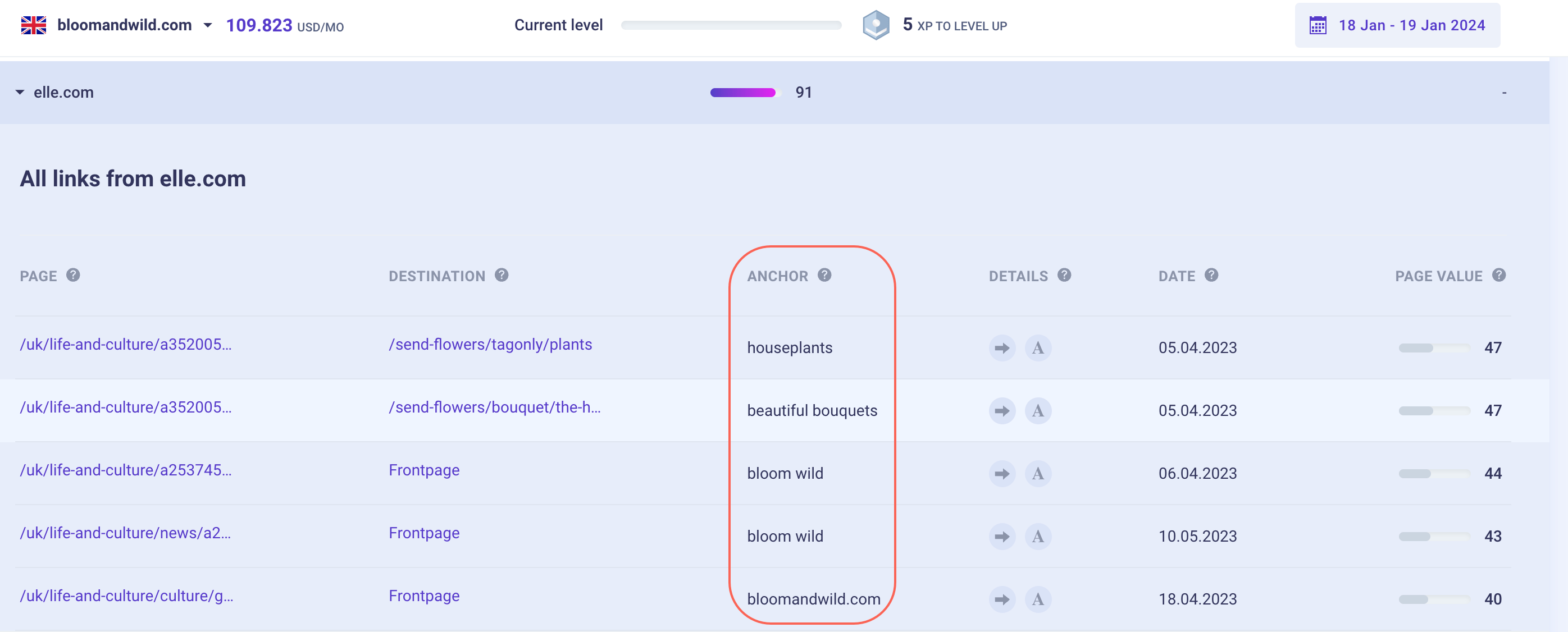
See an example of anchor text variation from Bloom & Wild in Elle online magazine. As is the case with most good and natural link profiles, the majority of their anchor texts are made of their brand name.
What is a bad backlink profile?
Bad backlink profiles typically contain far more poor and low-quality backlinks than good and authoritative ones. Their backlinks appear unnatural, with a focus more on the quantity than the quality of the links. Additionally, the distribution of their anchor texts is problematic, often overloaded with target keywords.
Websites with bad backlink profiles typically:
-
Have a lot of backlinks from spammy or irrelevant sites
These can include low-quality directories, websites that participate in link farms and acquire backlinks through paid schemes or link exchanges, unrelated blogs, or sites filled with low-quality content and broken links.
-
Acquire a large volume of backlinks in a short period
If there are a lot of links suddenly coming from low-quality sources, this is a sign of a bad backlink profile.
-
Have backlinks with naked URLs, empty or over-optimized anchor texts
Sites that have an unnaturally high number of backlinks with keyword-rich anchor texts or naked URLs can signal a bad backlink profile.
What does a poor-quality backlink profile look like:
To show you a concrete example of a bad backlink profile, we have chosen a random website. No name will be revealed to avoid harming it in any way. We can say it is a platform dedicated to the trail running community. The site encourages users to share their trail running stories.
Firstly, let’s examine the distribution of their links. More than two-thirds of their link profile is made of low-quality backlinks.
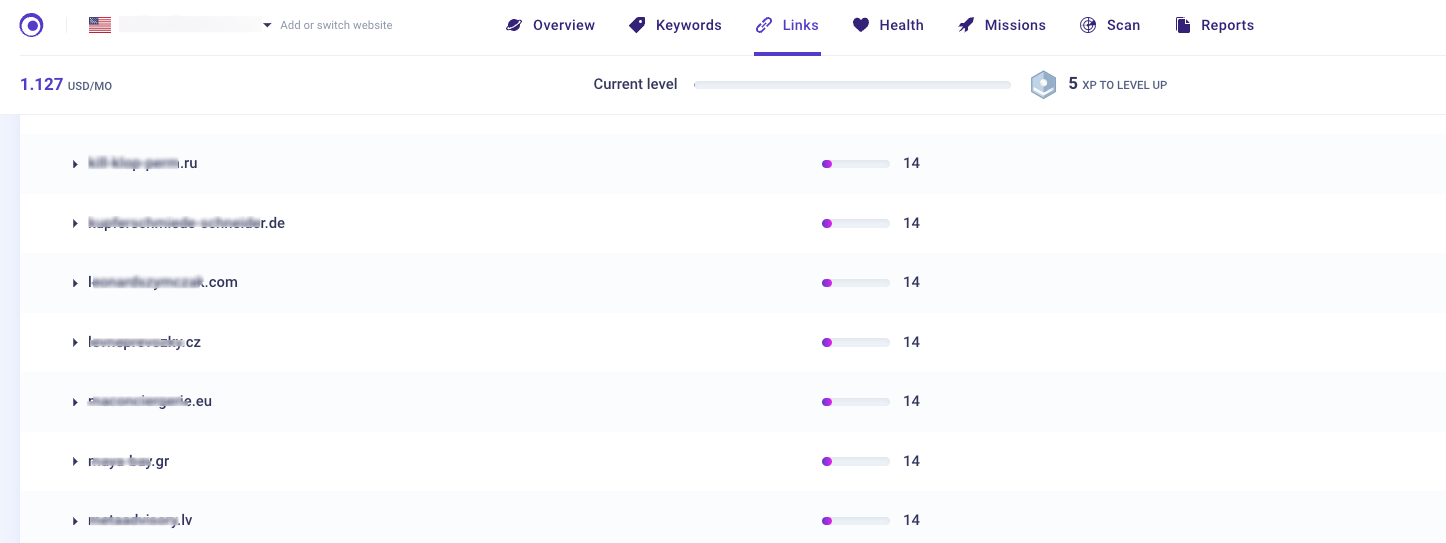
But this doesn’t give us the full picture. A website can still perfectly rank high with a backlink profile that looks like that if you don’t have all the details. Because of that, we need to examine their anchor text distribution.

What we can see from Morniscore’s backlink checker, is that the anchor texts containing one of their target keywords are over 30%. That’s close to one-third of all their anchor texts – a dangerous game. In contrast, their naked URL anchor texts are almost blown out of proportion – they are more than a third of all anchors.
The proportion of empty anchor texts is also quite high, indicating many low-quality spammy links. That’s because real websites that intend to link to them will use some text in the anchor text.
Last, but not least, we looked at just how few of their total anchor texts are branded. All of these indicate controversial link-building practices, making their backlink profile bad.
Conclusion
In conclusion, a backlink profile is the collection of all links pointing to your website. Building a good backlink profile is a long-term strategy that requires consistent effort. It’s important to regularly audit your backlink profile to identify any low-quality or harmful links, especially while you’re actively working with link building.
Remember, quality is far more important than quantity when it comes to backlinks. To improve your backlink profile, you need more contextual links from high-authority websites.
For effective management and analysis of your backlink profile, a backlink checker significantly simplifies the process of analyzing and understanding both your own and your competitors’ backlinks. Such tools are great in providing the insights you need to make informed decisions about your SEO strategy.
When building links, you can analyze not only your own link profile but also those of the websites you’re trying to get links from. Doing this ensures you understand the quality and authoritativeness of the linking websites. It also protects you from harming your rankings through bad backlinks.
Last but not least, you can also analyze the backlink profile of your competitors, allowing you to judge how competitive your market space is. Doing this can give you a good idea of how much effort you need to put into SEO to rank at the top. In turn, this can bring you a healthy, sustainable amount of website traffic that grows your business.

